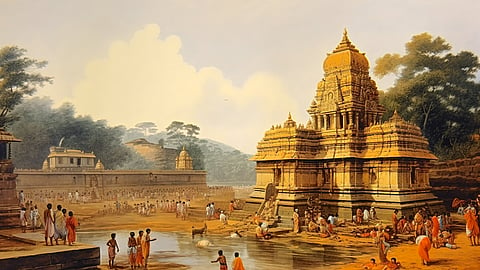- Commentary
- History Vignettes
- Notes on Culture
- Dispatches
- Podcasts
- Indian LanguagesIndian Languages
- Support

IF OUR RISHIS laid the philosophical and spiritual foundations of the Sanatana civilisation, our artisans and craftsmen used their hands and tools to create the physical elements that made it possible to function. They built our cities and towns and homes and temples. They created the utensils and implements for our daily use, and they embellished all these with fine artistry. And they were built to last. What are now known as antiques were once necessities of everyday life. The fact that some of these have survived for more than a millennium is a testimony to their durability.
As in other spheres of our civilisational heritage, we notice an unbroken continuity even in the material history of Bharatavarsha. Although the so-called industrial revolution delivered a death blow to our artisans, craftsmen and other professionals, they have somehow managed to survive minus the past glory and the primacy they had enjoyed. What is touted today as “hand made” is actually made by the descendants of folks who once dominated our business, social, cultural and religious fabric and enriched our national life with their contributions.
The Vira-Pancaḻas (ಪಂಚಳ, పంచళ, पंचळ. পংচळ, பஂசள., പംചള) were one such group of artisans who flourished mainly in the Kannada, Tamil and Telugu Deshas continuously for more than three hundred years. They were organic offshoots of the larger tree of our business and mercantile guilds, which were ubiquitous throughout Bharatavarsha beginning from the Vedic period. See the series on The Dharma Dispatch on the corporate life of ancient India, linked below.
THE EARLIEST MENTION of the Pancaḻas occurs in the 12th century in the reign of the Hoysala emperor Vira Ballala II. An inscription dated 1197-98 found in the Harapanahalli Taluk, Bellary district, records the grant of different cesses levied on a variety of professions. One part of these levies was made as an offering to the famous Virupaksha Temple at Hampi and the other part, for feeding Brahmanas in the town. The Kannada term pancakāruka-dere occurs in this inscription. Here, the word pancakāruka means a group of five artisans who typically included carpenters, goldsmiths, blacksmiths, masons and braziers. The term dere is the conjoined (Sandhi) form of the word tere, meaning tax. Thus, pancakāruka-dere means “tax levied on the pancakārukās). These professionals were the inevitable constituents of every town and village. Depending on a specific kingdom, region, custom and usage, other professionals were also included in the pancakāruka group: weavers, barbers, washermen and cobblers.
The term Pancaḻa is a synonym for pancakāruka. The Tamil equivalent is Pancaḻan.
Even a cursory study of the Pancaḻas opens up a brilliant slice of the Sanatana social superstructure and helps us in busting the colonial, communist and Congress myths about the Hindu social organisation. Our story in this essay complements the story of the extraordinary barber Kondoja who rose to great power during the de facto regime of “Aliya” Ramaraya.
AFTER THE BLOODLESS TRANSFER of power from the Hoysala House to the House of the Sangama, we notice quite a meteoric ascent of the Pancaḻas especially in the Old Mysore region. The stronghold of their power and dominance was in the general area known as the eṇṇe-nāḍu (literally, “oil region”) comprising the contemporary towns of Nanjanagudu, Gundlupete, Terakanambi, Chamarajanagara, and Haradanahalli (not to be confused with its namesake in the Hassan district). Even here, we notice the uninterrupted legacy of the Vijayanagara Empire which was eventually carried on by the Mysore Wodeyars. Under Wodeyar patronage, Terakanambi for example, emerged as one of the distinguished seats of Vedic and Sastric learning for a minimum of three centuries. As boys, several Mysore Wodeyars took their early education here. It also used to be renowned as a hub of Sri Vaishnava philosophy. It breaks the heart to see its present condition of disrepair and ruin.
By the end of the reign of Bukkaraya I (1356-77), the Pancaḻas had become a force to reckon with both in society and politics. For example, they wielded considerable influence over Bukkaraya’s son, Chikka-Kampana Wodeyar who was the Governor of the Mysore region. Pancaḻas had the power to impose various taxes on and excommunicate their members not only from the town but to debar them from their profession itself. They had become the undisputed masters in gemstone trading, jewellery-making and merchandising of various goods. They played a key role in local, provincial and central politics. They had a decisive voice in town council meetings. They also used their power and influence for constructive purposes. They organised large santhes (open-air business fairs typically held on a large ground) and jaatres (devotional fairs which included amusements and games of various kinds). They were fabled as educationists and philantrophists. They donated liberally to temples and charitable organisations.
An inscription dated 1372, discovered at the Rameswara Temple at Gundlupet narrates the story of a grant given by the Pancaḻas. It is perhaps the most representative and detailed record of their preeminence in that period. In this inscription, they address themselves as Vira Pancaḻas — literally, “Heroic Pancaḻas.”
That story will be narrated in the next episode of this series.
To be continued
The Dharma Dispatch is now available on Telegram! For original and insightful narratives on Indian Culture and History, subscribe to us on Telegram.
